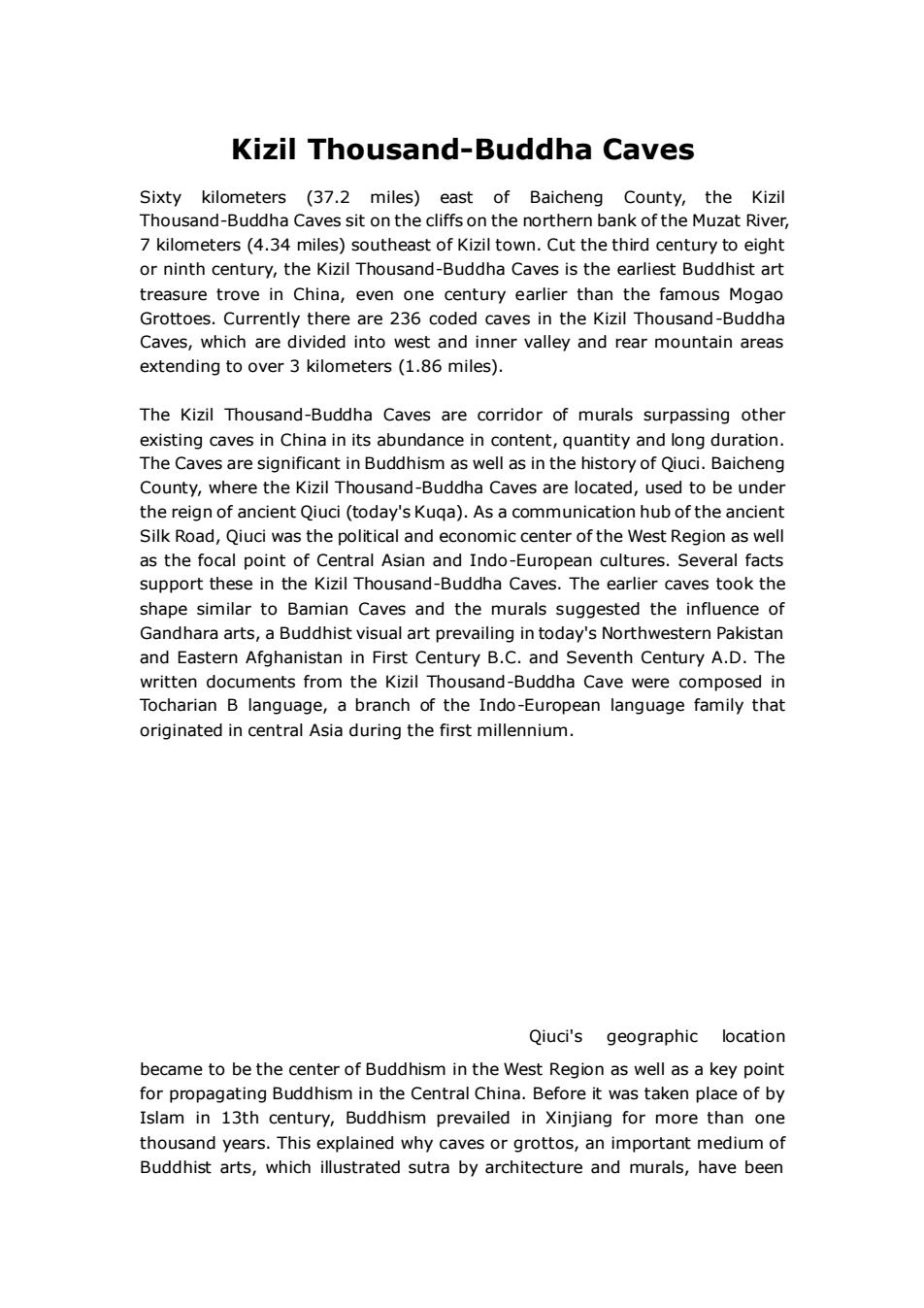正在加载图片...

Kizil Thousand-Buddha Caves Sixty kilometers (37.2 miles)east of Baicheng County,the Kizil Thousand-Buddha Caves sit on the cliffs on the northern bank of the Muzat River, 7 kilometers(4.34 miles)southeast of Kizil town.Cut the third century to eight or ninth century.the kizil thousand-Buddha caves is the earliest buddhist art treasure trove in China,even one century earlier than the famous Moga Grottoes.Currently there are 236 coded caves in the Kizil Thousand-Buddha Caves,which are divided into west and inner valley and rear mountain areas extending to over 3 kilometers(1.86 miles). The Kizil Thousand-Buddha Caves are corridor of murals surpassing other existing caves in China in its abu ndance in content,quantity and long duration The Caves are significant in Buddhism as well as in the history of Qiuci.Baicheng County,where the Kizil Thousand-Buddha Caves are located,used to be under the reign of ancient Qiuci(today's Kuga).As a communication hub of the ancient Silk Road,Qiuci was the political and economic center of the West Region as well as the e focal point of C t0 I Asian ope res.Several fa support these in the Kizil Thousand-Buddha Caves.The earlier caves took the shape similar to Bamian Caves and the murals suggested the influence of Gandhara arts,a Buddhist visual art prevailing in today's Northwestern Pakistan and Eastern Afghanistan in First Century B.C.and Seventh Century A.D.The written docu nents from the Kizi and-Bu ddha Cav wer sed in Tocharian B language,a branch of the Indo-Europeananguage family that originated in central Asia during the first millennium. Qiuci's geographic location became to be the center of Buddhism in the West Region as well as a key point for propagating Buddhism in the Central China.Before it was taken place of by Islam in 13th century,Buddhism prevailed in Xinjiang for more than one thousand years.This explained why caves or grottos,an important medium of Buddhist arts,which illustrated sutra by architecture and murals,have beenKizil Thousand-Buddha Caves Sixty kilometers (37.2 miles) east of Baicheng County, the Kizil Thousand-Buddha Caves sit on the cliffs on the northern bank of the Muzat River, 7 kilometers (4.34 miles) southeast of Kizil town. Cut the third century to eight or ninth century, the Kizil Thousand-Buddha Caves is the earliest Buddhist art treasure trove in China, even one century earlier than the famous Mogao Grottoes. Currently there are 236 coded caves in the Kizil Thousand-Buddha Caves, which are divided into west and inner valley and rear mountain areas extending to over 3 kilometers (1.86 miles). The Kizil Thousand-Buddha Caves are corridor of murals surpassing other existing caves in China in its abundance in content, quantity and long duration. The Caves are significant in Buddhism as well as in the history of Qiuci. Baicheng County, where the Kizil Thousand-Buddha Caves are located, used to be under the reign of ancient Qiuci (today's Kuqa). As a communication hub of the ancient Silk Road, Qiuci was the political and economic center of the West Region as well as the focal point of Central Asian and Indo-European cultures. Several facts support these in the Kizil Thousand-Buddha Caves. The earlier caves took the shape similar to Bamian Caves and the murals suggested the influence of Gandhara arts, a Buddhist visual art prevailing in today's Northwestern Pakistan and Eastern Afghanistan in First Century B.C. and Seventh Century A.D. The written documents from the Kizil Thousand-Buddha Cave were composed in Tocharian B language, a branch of the Indo-European language family that originated in central Asia during the first millennium. Qiuci's geographic location became to be the center of Buddhism in the West Region as well as a key point for propagating Buddhism in the Central China. Before it was taken place of by Islam in 13th century, Buddhism prevailed in Xinjiang for more than one thousand years. This explained why caves or grottos, an important medium of Buddhist arts, which illustrated sutra by architecture and murals, have been